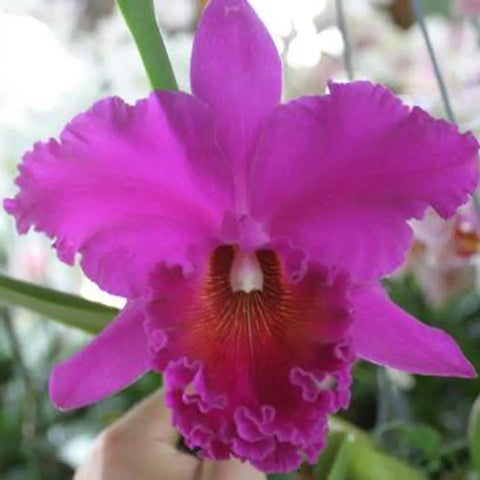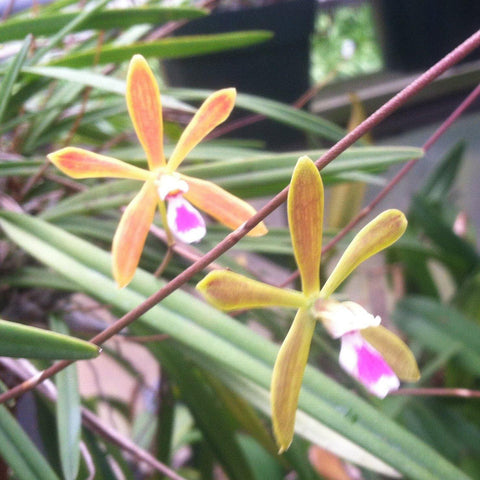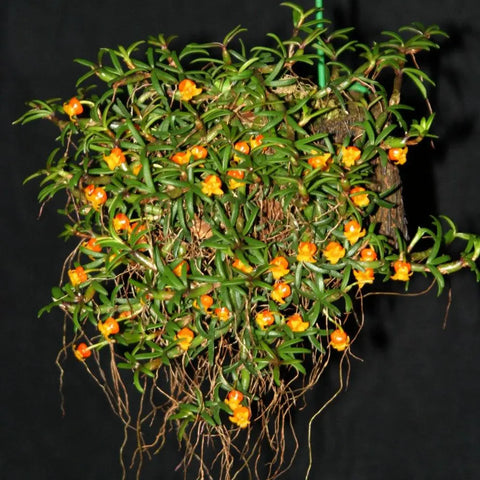Blc. (Eagle Island `Sangria' AM/AOS x Orglades Royal Lady `Roman Holiday' AM/AOS) 2.5" Pot
Blc. (Eagle Island `Sangria' AM/AOS x Orglades Royal Lady `Roman Holiday' AM/AOS)
This promising hybrid combines two richly colored parents: Blc. Eagle Island ‘Sangria’ AM/AOS, known for its deep wine-red blooms, and Lc. Orglade’s Royal Lady ‘Roman Holiday’ AM/AOS, an equally dramatic red with excellent form. Expect large, intensely saturated flowers with deep red to burgundy hues and potential for show-quality shape.
The photos provided show the award-winning parent plants, giving a glimpse into the range of color and form this cross is expected to express. These young plants are in 2.5" pots and will need approximately 3 years to reach blooming size.
Why Growers Are Excited About This Cross
This hybrid is all about color impact. With both parents carrying AOS awards and a strong winter blooming tendency, it's a standout for collectors looking to expand their red Cattleya collection. Ideal for growers with patience—this seedling has the potential to produce show-quality flowers in vibrant shades with strong substance and heavy texture.
Botanical Profile
- Hybrid Name: Brassolaeliocattleya (Blc.) Eagle Island ‘Sangria’ × Laeliocattleya (Lc.) Orglade’s Royal Lady ‘Roman Holiday’
- Parentage: Blc. Eagle Island ‘Sangria’ AM/AOS × Lc. Orglade’s Royal Lady ‘Roman Holiday’ AM/AOS
- Registered By: Unregistered Hybrid
- Pot Size: 2.5"
- Growth Stage: 3 Years to Blooming Size
- Bloom Size & Form: Expected large blooms with broad petals and well-defined lips
- Color: Deep red, burgundy, or wine tones; rich saturation from both parents
- Fragrance: Unknown (pending first blooms)
- Bloom Season: Primarily winter
- Growth Habit: Compact to medium; upright pseudobulbs
- Foliage: Broad leaves; grows well in pots with strong light and airflow
Cattleya Culture
Light is the most important factor in growing and flowering cattleyas, whether in a greenhouse or in the home. Bright light to some sun should be given to the plants, with no direct sun in the middle of the day. This means an east, shaded south (as with a sheer curtain) or west window in the home, and 50 to 70 percent full sun in a greenhouse (3,000 to 5,000 foot-candles). Leaves should be a medium green color, pseudobulbs erect and requiring no staking.
Temperatures should be 55 to 60 F at night and 70 to 85 F during the day. Seedlings should have night temperatures five to 10 degrees higher. A 15- to 20-degree differential between day and night is recommended, especially for mature plants. Higher day temperatures can be tolerated (up to 95 F), if humidity, air circulation and shading are increased.
Water should be provided in two ways: in the pot by watering and in the air as humidity. Watering in the container is dictated by many criteria: size and type of the vessel, temperature, light, etc. Mature cattleyas need to dry out thoroughly before being watered again. Seedlings need more constant moisture. Compare the weight of a dry pot of the same size and type of mix; it can indicate if a plant needs water by the relative weight - light means dry, heavy means wet. If in doubt, it's best to wait a day or two until watering. Plants in active growth need more water than plants that are resting. Water below 50 F may injure plants, as will water softened by the addition of salts.
Humidity should be 50 to 80 percent for cattleyas. This can be provided in the home by placing the plants on trays of gravel, only partially filled with water so that the plants do not sit in the water. Air should always be moving around the plants to prevent fungal or bacterial disease, especially if high humidity or cool temperatures exist. In the greenhouse, the humidity is best increased by use of a humidifier. Evaporative cooling increases humidity while cooling the air.
Fertilize on a regular schedule. In fir bark, a high-nitrogen (such as 30-10-10) formulation, or a similar proportion, is used. Otherwise, use a balanced fertilizer. When in active growth, plants need fertilizer at least every two weeks, and when not actively growing, once a month. Fertilizer can also be applied with every watering at one-quarter the recommended dilution. Thorough flushing with clear water every month is recommended to prevent the buildup of fertilizer salts.
Potting is necessary when the rhizome of the plants protrudes over the edge of the pot or the potting medium starts to break down and drain poorly (usually after two to three years). It is best to repot just before new roots sprout from the rhizome, after flowering or in the spring. Mature cattleyas are usually potted in coarser potting material than are seedlings. Until a plant has at least six mature pseudobulbs, it generally should be put into a larger pot and not divided. If dividing a plant, three to five pseudobulbs per division are required. Select a pot that will allow for approximately two years of growth before crowding the pot. Pile mix against one side of the pot and cut off any dead roots. Spread the firm, live roots over the pile, with the cut rhizome against the side of the pot. Fill the pot with medium, working it around the roots. Pack firmly and stake if necessary. Keep the plant humid, shaded and dry at the roots until new root growth is seen.
We Also Recommend







